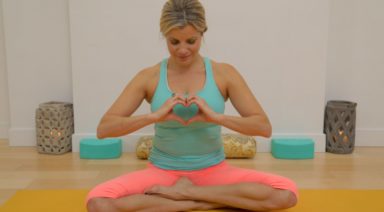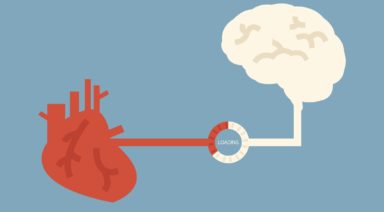10 Reasons to Make Inner Peace a Priority

Inner peace is the eternal quest for seekers everywhere. What used to be a rather vague and ephemeral concept has since been backed by modern science as a worthwhile quest towards accessing better health and happiness.
If you’re wary about the real-life importance of making peace of mind a priority, you’re not alone. The monkey mind is a cultural norm and, for most people, daily life consists of a constant stream of chaotic thoughts based in the past or the future.
Rarely do people make the space for presence and the experience of simply being. But when you do, you’ll be astonished how life can shift from tumultuous to serene, from judgemental to accepting. You can find inner peace even in the midst of external chaos.
1. Increased Intelligence
Perhaps one of the most popular benefits that inner peace can bring is the potential to grow your brain, literally. A study done at Harvard University showed that people who practiced mindfulness meditation (quick definition: accepting and paying attention to your thoughts and feelings without judgment) increased the thickness of their prefrontal cortex.
The prefrontal cortex is the part of the brain responsible for regulating emotions, planning, decision making, and regulating social behavior. Just eight weeks of regular meditation practice also shows increased gray matter in MRI scans.
Turns out that seeking peace helps you gain greater intelligence and a stronger, healthier brain.
2. Rewire Your Brain for Positive Feedback Loops
You can change your brain and it’s as easy as being aware of the transience of every experience. Most people go into a fight or flight stress state at least a few times a day, but when peace is your primary pathway you can change that mental habit.
This is because our unconscious thoughts and worries (aka the monkey mind) engage the amygdala, the reptilian part of our brains responsible for keeping us alive in dangerous situations. When the amygdala is engaged we experience anxiety, tension, faster heart rate, and poor digestion, all things modern humans are very familiar with.
When peace is the primary pathway you can consciously comfort your amygdala with the assurance that all is well and the world is NOT ending. Because our brains are plastic and changeable you can change the tendency to activate the amygdala and remain calm even in the midst of chaos.
3. Grow Your Compassion Muscle
The Dalai Lama says that “If you want others to be happy, practice compassion. If you want to be happy, practice compassion.” Yet often we’re too absorbed in our busy lives to experience wholehearted compassion for both ourselves and our fellow humans.
A study published in the journal Psychological Science found that the practice of meditation and the allowing and acceptance that comes along with it increases the internal experience of compassion. Another study showed this affects the brain even when you’re not actively engaged in meditation.
4. More Happiness
Shawn Achor, the author of the book the Happiness Advantage, describes creating your own happiness through mindful practices rooted in peace as a mere mental reprogramming of sorts.
“We are basically trying to find an undiscovered path that if walked once, makes us happy. The path is the synaptic connections in our brain. And then, because we enjoy it, we go along that path, hundreds and hundreds of times. Slowly a track forms and becomes very clear and easier to walk every time.”
The human brain has a tendency to emphasize the negative, breeding more of the same. But when peace becomes your primary objective and you hold that goal in mind, it’s entirely possible to increase your happiness merely by being conscious of that desire.
The power of positive thinking is well-studied and recognized throughout the medical community to be a powerful practice in achieving greater overall well-being. A large part of creating inner peace is letting go of negative self-talk and replacing those habits with gratitude. Even in a study where participants were challenged to focus on just three things they’re grateful for each day the results were promising for creating greater happiness and overall satisfaction.
5. Protection Against Age-Related Mental Decline
The brain that seeks peace in the brain that remains spry and sharp, regardless of age. One study showed even just 10 minutes of mindfulness meditation a day dramatically slows age-related cognitive decline.
The why behind this dwells in the first point, as the peaceful practice of meditation helps to grow the areas of the brain that typically dwindle in effectiveness with age.
6. Improved Digestion
Stress is inextricably linked to digestive health and, although it may seem boring to some, good digestion is essential for radiant physical health, energy, and mental health. The brain-gut axis is the biochemical signaling that takes place between the central nervous system and the gastrointestinal tract. The gut is a part of our nervous system and, in a sense, it acts as a second brain.
The reason stress affects digestion is because of specific biochemical signals which negatively affect the gut and even the bacteria that reside there!
When you’re primary pathway and response to life’s stressors is a desire to maintain peace and neutrality and you have the skillset to do that, your digestive health and your body’s second brain will be well balanced and give you the energy you need to live life to it’s fullest potential.
7. Increased Focus and Memory
A study of 48 students randomly assigned to either a mindfulness class or a nutrition class showed that the students who practiced mindfulness for 45-minutes, four times per week for 4-weeks were far ahead in the focus department than their nutrition savvy counterparts. The mindfulness students got better test scores in completely unrelated topics as well as improved their memory retention.
Psychological scientist Michael Mrazek of the University of California and one of the researchers involved in the study stated, “We found reduced mind-wandering in every way we measured it and improved performance on both reading comprehension and working memory capacity”.
By simply being present and allowing thoughts to pass that aren’t in alignment with our authentic selves we create neural patterns that enable full immersion towards the task at hand. This kind of focus and productivity is rare in a world full of distractions, but simply by being present and allowing, you can access it at any moment.
8. Enhanced Immune Function
The human immune system has a large burden to bear. It’s constantly fighting and protecting us from harmful foreign invaders and when we’re stressed out its burden becomes amplified.
Stress suppresses immune function and makes you more susceptible to illness. If you’ve ever had one of those months (or seasons) where you feel like you’re catching every bug there is, take a closer look and analyze what your stress levels were like at that point.
The good news is you can support your immune system by training your brain to boost it. The proof is in the pudding and it’s clear through a systematic review of various controlled trials that mindfulness, the energy of allowing and letting go of thoughts instead of clinging to them and their emotional imprints, has a dramatic effect on the immune system.
This review pointed out some very important immunological effects of mindfulness:
- Lower levels of inflammatory markers
- Increased numbers of the immune systems CD4 “helper cells”
- Preservation of telomeres, the caps at the end of our chromosomes (whose degradation is also associated with premature aging)
9. Improved Mental Health
So many people suffer from depression and anxiety and the reasons for this are varied. The pharmaceutical companies would like us to think that it’s merely a chemical imbalance, but it’s clear it is much more than that alone.
Often, life becomes so overwhelming that the nervous systems’ way of defending itself is to just shut down or go into hyperdrive. The conditions that result from this can be balanced out when time and space is made for stillness, integration, reflection, and processing of thoughts and emotions with the intention to not become attached to them.
A meta-analysis looked at six randomized controlled clinical trials to see if mindfulness in conjunction with cognitive-behavioral methods (aka positive thinking and training the brain to stop the vicious cycles of self-defeating thought patterns) were effective at keeping depression at bay. The findings suggest that these techniques could reduce the relapse of depression in up to 44% of patients, which is basically on par with that of antidepressants.
Another meta-analysis of 47 clinical trials found that meditation can ease general psychological stress ranging from anxiety to depression and pain.
The journey towards greater peace inside of you can evidently diminish serious mental health problems that make greeting the outside world with openness so challenging.
10. Your Thoughts Create Your Reality
Bruce Lipton, a cell biologist and internationally recognized authority on how our beliefs shape our reality teaches that our genes aren’t set in stone. His research has shown that by changing your perception you can alter the activity of your genes. Gene programs contained within the nucleus of the cell can be rewritten through changing your blood chemistry.
Through stress reduction techniques like positive thinking and mindfulness, you can adjust your personal biology and potentially even heal your body from disease.
Lipton highlights that it isn’t so much the conscious thoughts that create these effects but the subconscious. “Your subconscious beliefs are working either for you or against you, but the truth is that you are not controlling your life because your subconscious mind supersedes all conscious control. So when you are trying to heal from a conscious level – citing affirmations and telling yourself you’re healthy – there may be an invisible subconscious program that’s sabotaging you.”
To get to the root of the subconscious beliefs you hold takes a systematic mental reprogramming and conscious awareness about the little thoughts that pop up for you and hold an energetic charge.
It is possible to rewrite your subconscious belief patterns and to be empowered in the potential that you have to create a vibrant life that is rooted in peace and unaffected by the chaos of the outside world.
With the right mental training strategies, you can effectively tame the monkey mind and find freedom from the very things which cause stress to show up in your life. When you train your brain to create new neural pathways rooted in happiness, you’ll be amazed at how that manifests in the external world and creates lasting freedom from mental strife. Inner peace is possible.
10 Signs That You're a Free Spirit

When we think of the term, “free spirit,” we imagine a person who steers their own course in life, unencumbered by common burdens or concerns. Some look at those who identify as free spirits as being irresponsible or childish, though this mindset offers lessons to inform us how we can live life on our own terms.
If you’re someone who considers yourself an independent thinker or doer, who pushes against society’s envelope and is deeply committed to finding your own path, you may be a free spirit. Are you curious as to whether the free spirit path is for you?
Ten Signs You’re A Real Free Spirit
If you identify with any of these signs, chances are you have a free spirit waiting to be let loose into the world!
1. You’re Independent-Minded
Independent people thrive on listening to their own voices, regardless of the situation or circumstance. This key personality trait of the free spirit is a common one in innovators, entrepreneurs, and creative artists, as an independent streak also relies on a strong foundation and belief in oneself.
Are you the person in the room who always finds a new way of looking at things? Free spirits defy expectations and will always see the unexpected in equally unlikely ways. These kinds of thinkers can be great assets on a creative team, as they will always find a new way to look at an idea. Free spirits are also incredible advocates for innovation, as they are not afraid to stand up and for their ideas, no matter how much it veers from the rest of the crowd.
2. Fear Doesn’t Stop You
Dale Carnegie said, “Do the thing you fear to do and keep on doing it… that is the quickest and surest way ever yet discovered to conquer fear.” Free spirits feel fear, but they don’t allow that feeling to be something that stops them. Instead, a free spirit will work through the fear and let it serve as a motivating factor. In fact, most free spirits will tell you that any success is not worth having unless it’s achieved with a healthy dose of moving through fear.
3. You Have a Strong Spine.
While it can be said that free spirits go with the flow of life, they accomplish it with a healthy and strong sense of self. This translates into living with intention and purpose and one that is not defined by anyone else. A free spirit walks the talk and in many cases, creates the language that makes up the talk.
4. Free From Attachment
To live as a free spirit, one has to be willing to let go, or walk away from the things that might weigh others down such as conventional relationships, careers, and other traditional trappings of modern life.
You might find a free spirit selling their material goods and living in a van, or not staying tethered to one place for very long. Or perhaps a free spirit may choose to live simply with a commitment to not participating in consumerism. Minimalism is often a choice of free spirits as this lifestyle embodies freedom from many of the things that weigh us down. Free spirits enjoy their own company and thrive on solo time, and putting themselves first.





































